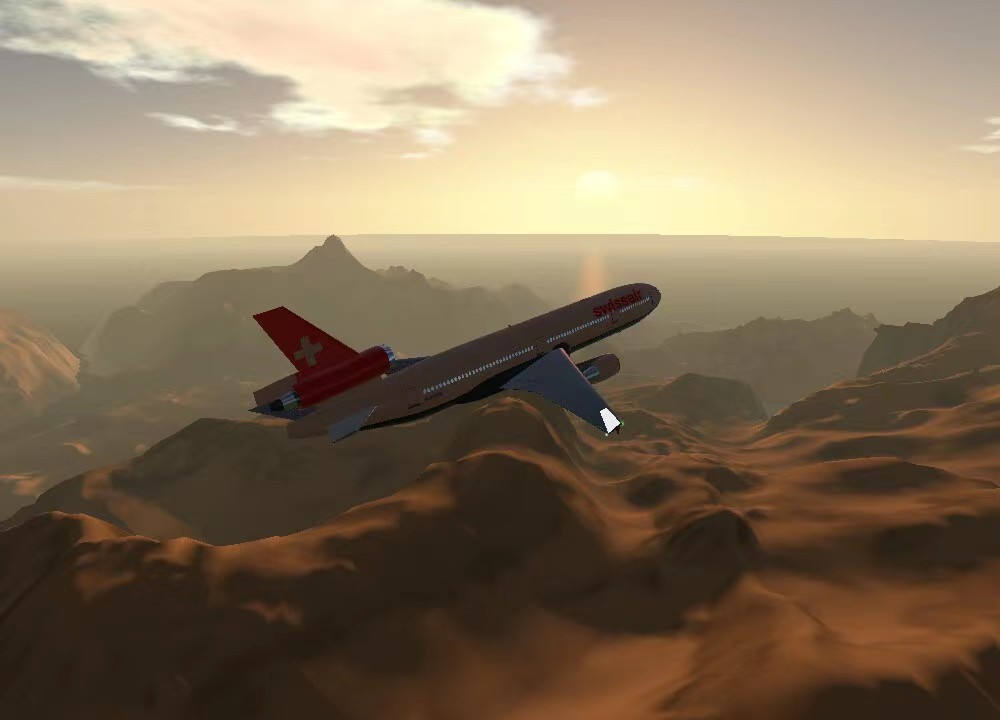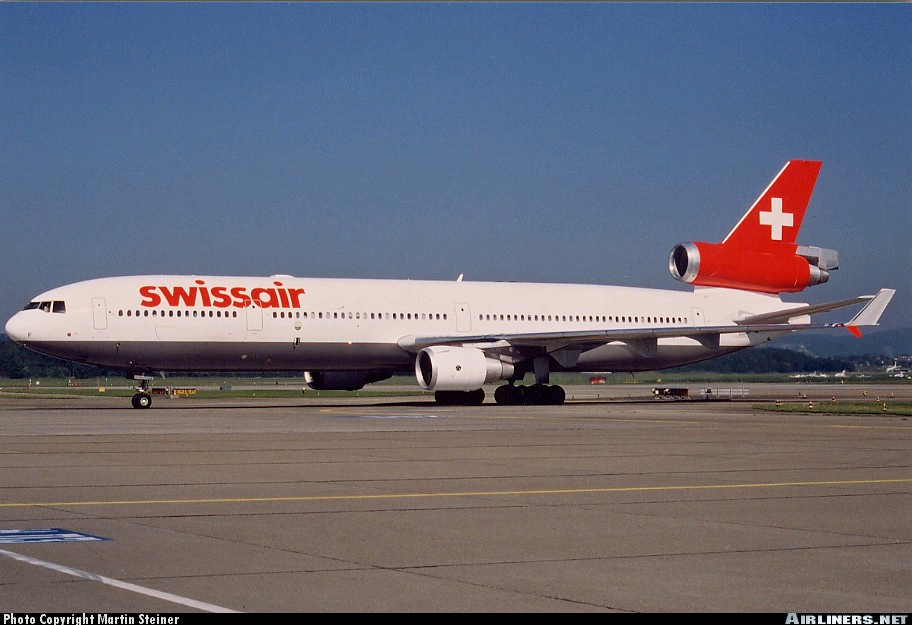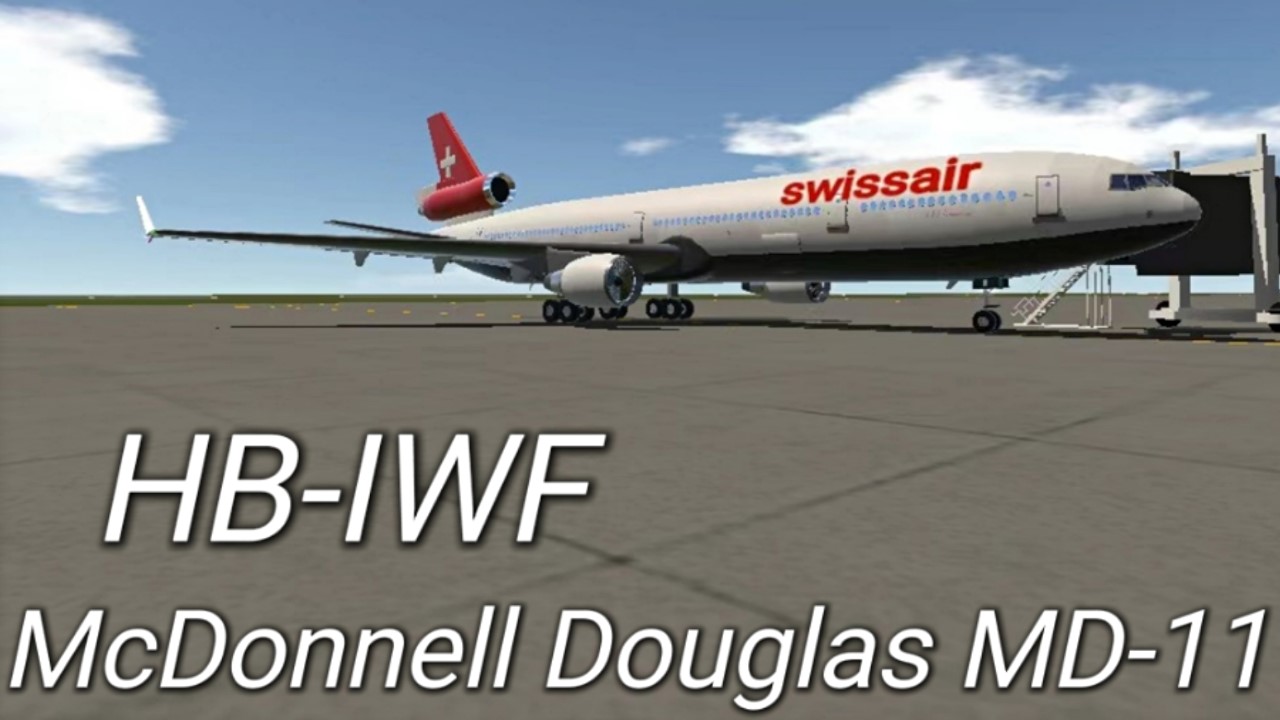Credit to @Marine for his KLM MD-11
About the history of McDonnell Douglas MD-11
The MD-11 is a modernised, slightly stretched and re-engined development of the DC-10 trijet. Launched on December 30 1986 (following a launch order from British Caledonian for three placed earlier that month), the MD-11 was the result of a two year study to find a replacement for the DC-10. First flight occurred on January 10 1990, certification was granted in November that year, and the first one was delivered on December 7 1990 to Finnair. Compared to the DC-10, the MD-11 features a 5.71m (18ft 9in) fuselage stretch, winglets, modified tail with less sweepback, an advanced two crew six screen EFIS flightdeck, restyled main cabin interior and new engine options. Variants offered were the longer range MD-11ER available from early 1996, MD-11F freighter, MD-11C Combi and MD-11CF convertible passenger/freighter models. McDonnell Douglas at various times proposed MD-11 developments aimed at increasing seating through stretches and underfloor panorama deck seating. In 1996 MDC looked closely at the MD-XX, MD-11 variants with a new wing. Two versions were proposed, one with the standard MD-11 fuselage and a 15,565km (8400nm) range, the other a stretched 375 seater. These were not launched. In November 1997 following the Boeing/McDonnell Douglas merger Boeing announced that the MD-11 would be retained in production, primarily as a freighter. However in June 1998 Boeing reversed that decision, saying that due to a lack of market demand production would be wound up. The last MD-11 built, a MD-11F for Lufthansa cargo, was delivered February 22 2001.
This aircraft was delivered to Swiss airlines as the sixth MD-11 in the fleet on August 5, 1991. It is equipped with three Pratt & Whitney PW4462 engines with a single thrust of 276kn (62000lb). At first, this aircraft was named "Schaffhausen" until August 1992, and then it was named "Vaud" until September 2, 1998
About the crash of Swissair flight 111
The air crash of Swissair flight 111 occurred in the sea area near Halifax Airport in Canada in the early morning of September 2, 1998. The crashed plane was a MD-11 three engine wide body passenger plane belonging to Swissair with the number HB-IWF. After crashing into the Atlantic Ocean, the plane disintegrated, and 229 people on board survived. This incident undoubtedly made Swissair, which was originally in poor operating conditions, worse. It indirectly led to the bankruptcy of the company in October 2001 and the reorganization of the company into Swiss International Airlines on March 31, 2002.
The crashed aircraft was a MD-11 manufactured in 1991, with production serial number of 48448 and equipped with three Pratt Whitney PW4462 engines. Before the crash, it had flown 36041 hours. At the time of the accident, the plane had 241 seats: 12 first-class seats (six seats in each row), 49 business seats (seven seats in each row) and 180 economic seats (nine seats in each row). At 8:18 p.m. local time, Swissair flight 111 (then associated with Delta Airlines) took off from Kennedy International Airport in New York and went to Geneva International Airport in Switzerland. When the plane reached an altitude of 33000 feet, both the captain and the co pilot smelled a strange smell from the air-conditioning system on the plane. After four minutes, the two pilots could see white smoke coming out. However, smoke and white smoke only appear in the cockpit, and there is no such phenomenon in the cabin. Therefore, the pilot thinks that there is something wrong with the air conditioning in the cockpit. At this time, the captain wanted to make an emergency landing at the nearest airport, so he contacted the Moncton regional dispatcher to say that there was an emergency on the plane. However, the Moncton Regional Bureau instructed the passenger plane to fly to Halifax International Airport, the capital of Nova Scotia, Canada.
At 10:19 PM, the plane had flown 56 kilometers away from Halifax Airport, requested to descend to an altitude of 21000 feet, and indicated to air traffic control that it would release the fuel on board to prepare for an emergency landing. However, the electronic components on the plane failed one after another. At 10:24 PM, the captain announced that the plane had entered a state of emergency and told the controller that it was necessary to land "immediately". However, the lights, navigation instruments and auto drive system on the plane have all failed. As a result, the plane lost contact with air traffic control at 10:25. One minute before the plane crashed, the No. 2 engine was turned off; Finally, it fell to the Atlantic Ocean at a speed of 350 knots.
After the plane crashed, the whole plane was divided into millions of pieces. The largest pieces were the engine and landing gear of the plane. At first, the investigation was in trouble. According to the flight controller on duty that night and the black box data, the investigators learned that the plane crashed due to fire. However, in the face of millions of aircraft debris, there was no way to investigate the cause of the fire.
In the second year of the investigation into the cause of the air crash, more than one million pieces of debris of flight 111 were salvaged. The researchers found that there was an arc on one of the wires, which led to the conclusion that the spark caused by the short circuit of the wires ignited the polyethylene terephthalate (PET) insulation layer, and then the pet insulation layer ignited other things. The short circuit of the power line was caused by a modification of the plane before the accident. At that time, in order to attract more passengers, Swiss Airlines added a set of advanced entertainment system to the first-class cabin of the plane. Through this system, passengers can browse the Internet at their own positions and even play gambling games through credit cards. However, adding such a device to the normal circuit system of the aircraft undoubtedly increases the burden of the system. What is more fatal is that such a system is not provided with a switch to turn it off when necessary. Finally, the overheated wires ignited the insulation and caused a fire. The fire broke the wires of the black box six minutes before the crash, and began to burn other wires. A few minutes before the crash, the electronic components on the plane failed one by one, and the speed was very fast. At the moment before the crash, only a few devices could operate normally. At the beginning of the fire, the crew did not know that it was the short circuit of the power line that caused the fire. They just thought that the air-conditioning system on the aircraft was out of order, so they underestimated the seriousness of the incident. Otherwise, the crew must immediately declare a state of emergency. The investigators also found that six minutes before the crash, only the co pilot in the cockpit was controlling the plane, and the captain was missing. The investigator speculated that the captain was putting out the fire at that time, but the situation at that time was beyond the control of the crew. As a result, the captain may have died in the fight. In any case, the co pilot of flight 111, which lost its captain, was the only pilot, and the co pilot might not be familiar with the airport environment requiring emergency landing. As a result, the aircraft constantly wandered around the crash site to find the airport location. Finally, with the time-consuming situation, the aircraft broke down one after another until it fell into the sea.
In Game


Real Photos


Remake place:
1. Added gray paint on the lower part of the original aircraft.
2. Modified the number of aircraft windows to the number of the original aircraft.
3. Added many details on the original aircraft.
4. Modified the color on the vertical tail and No. 2 engine.
5. Modified the cross on the vertical tail to the pattern on the original aircraft.
6. Modified the CF6-80C2D1F engine of General Electric on the original aircraft to the PW4462 engine of Pratt & Whitney
Have a nice flight!
Specifications
Spotlights
- DJRianGamer2009 3.4 years ago
- Zerkk 1.4 years ago
General Characteristics
- Predecessor MD-11 KLM
- Successors 13 airplane(s) +297 bonus
- Created On Android
- Wingspan 171.7ft (52.3m)
- Length 201.2ft (61.3m)
- Height 58.5ft (17.8m)
- Empty Weight 350,139lbs (158,820kg)
- Loaded Weight 579,612lbs (262,907kg)
Performance
- Power/Weight Ratio 0.584
- Wing Loading 24.8lbs/ft2 (121.2kg/m2)
- Wing Area 23,346.4ft2 (2,169.0m2)
- Drag Points 80413
Parts
- Number of Parts 795
- Control Surfaces 12
- Performance Cost 3,678







@Sunsun27 it’s swissair 111
Swiss 11
@RASairlines Sure, you can use it as you please.
can i use this as a template for my airline il credit!
@FeiGe3 ok thx
@Pilothasya137 Vaud is one of the 26 states that make up the Swiss Confederation, with ten districts. The capital city is Lausanne, and it is also the third largest continent in Demographics of Switzerland in population and the fourth largest continent in area. In addition to HB-IWF, in Swissair, there are also Douglas DC-6B HB-IBU, Covair CV-990-30A HB-ICE, Douglas DC-10-30 HB-IHE, McDonnell Douglas MD-11 HB-IWC, and HB-IWF did not use the name Vaud from 1991 to 1992, Instead, the name Schaffhausen was used. After 1992, HB-IWF changed its name to Vaud, while the original Schaffhausen was used by HB-IWC. However, after the September 2, 1998, Halifax disaster in Swissair Flight 111, the name Vaud was never used again, until March 31, 2002, Swissair officially completed its business. But if you want to know more about Swissair, You can search for relevant information on two websites in the Swiss Fansite in the introduction of the Swissair A340-600 that I have published.
@FeiGe3 ok tysm,but how about the "vaud" name?
@Pilothasya137 This MD-11 certainly has a name, and there is the name and flag of this aircraft below the four windows behind the L2 and R2 doors of the original aircraft. However, due to technical reasons, it was not produced during the production of this aircraft. Sorry.
did thid aircraft have a aircraft name? cus i dont see it
"rauf"
I sincerely thank all the people who download this plane, post comments and upvote❤
Swiss001: is hard to land an MD-11